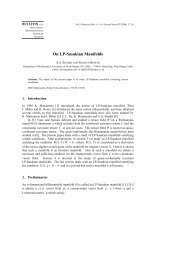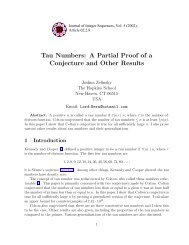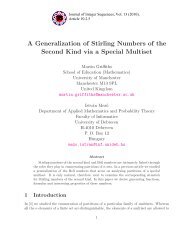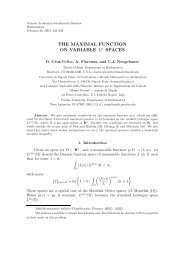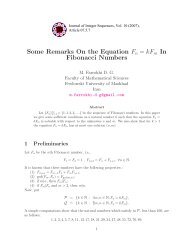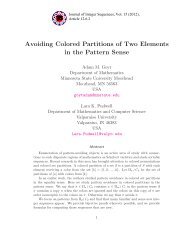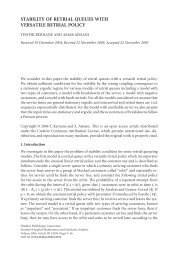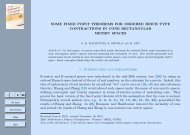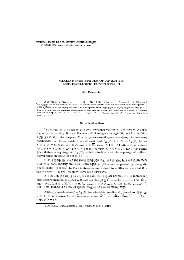Teachers' notes and lesson plans - University of Southampton
Teachers' notes and lesson plans - University of Southampton
Teachers' notes and lesson plans - University of Southampton
- No tags were found...
You also want an ePaper? Increase the reach of your titles
YUMPU automatically turns print PDFs into web optimized ePapers that Google loves.
Welcome to the seventh National Cipher ChallengeThe competition will run from September 25th 2008 to January 1st 2009. Over thenext few months you will be joining George Scovell <strong>and</strong> the Duke <strong>of</strong> Wellington intheir fight to eject Napoleon's army from Portugal <strong>and</strong> Spain.It will be your job to help the British army in its efforts to decipher French messagesintercepted by George Scovell's Army Guides <strong>and</strong> their brave allies the SpanishGuerilla fighters. As the war progresses <strong>and</strong> the French ciphers become harder tocrack you will need all your wit <strong>and</strong> skill to break them, <strong>and</strong> your hardest Challengewill be to break the Great Paris Cipher.Challenges will be set on the web-site www.cipher.maths.soton.ac.uk in theChallenges section, <strong>and</strong> will come in two parts. Part A will consist <strong>of</strong> letters, <strong>notes</strong><strong>and</strong> despatches from the British army. As they come from a military organisation in astate <strong>of</strong> war you can expect these messages to be formally (though, perhapssurprisingly, not heavily) encrypted. In the early stages <strong>of</strong> the campaign, before battleis joined in earnest these will be only lightly encrypted, although in the latter stages <strong>of</strong>the competition, as George Scovell takes a firm grip on the Army's communications,security will be tightened <strong>and</strong> you will find the part A ciphers harder to crack. Part Bconsists <strong>of</strong> intercepted messages between the elements <strong>of</strong> Napoleon's army. Thesemight be orders from Paris, or from Napoleon's brother King Joseph in Madrid, orthey may be intelligence reports between the four main forces in the field, the FrenchArmies in Portugal, the North, the South <strong>and</strong> the Centre. As Wellington concentrateshis forces for a major <strong>of</strong>fensive the French ciphers will become increasingly harder tocrack. As a result <strong>of</strong> the terrifying effectiveness <strong>of</strong> Scovell's field agents the Frenchciphers need to be, <strong>and</strong> are, much more securely encrypted than the British, thoughyou may find that the British messages themselves contain clues to the decryption <strong>of</strong>the French texts.If you get stuck on a Challenge don't give up, sometimes a good night's rest is all youneed. Other times you need more practical help <strong>and</strong> you can turn to the website forclues. You might find them posted as comments on the bulletin board, though we askyou not to post hints <strong>of</strong> your own without checking with us first as this will spoil theChallenge for others. Anyone posting solutions or links to solutions will be barredfrom the site <strong>and</strong> disqualified from the competition. You will also find clues in theChallenges themselves. So the solution to any previous Challenge may give hintsabout how the current one is encrypted. Also the part A message might give clues forpart B at each stage so it is worth deciphering the part A challenge even if your maininterest is the part B competition.The Challenges will be published at 3.15pm on a Thursday, according to the schedulegiven on the rules page <strong>of</strong> the website.www.cipher.maths.soton.ac.uk/rulesYou can submit your solution any time after the challenge has been published <strong>and</strong>before the deadline at one minute to midnight the day before the next Challenge ispublished. Solutions to each Challenge will be published after the deadline, so if you2
can't crack a particular Challenge don't give up. 24 hoursafter you submit you can check for feedback on yoursolution by logging in at the feedback page.www.cipher.maths.soton.ac.uk/feedback.phpIf you have submitted a solution with a mistake in it you cansubmit again (though watch out for rule 20). For eachChallenge you will receive a score based on your speed <strong>and</strong> accuracy, <strong>and</strong> we will usethese scores to compile a Leader Board for each Challenge. These lists will bepublished so you can see how you are getting on. The part B Leader Board will becompiled into the overall Championship Leader Board which will be used todetermine the winners <strong>of</strong> the competition. Entries for each challenge, which may befrom individuals or from teams, should be submitted using the submissions web-form.www.cipher.maths.soton.ac.uk/entryform.phpBe careful to follow the instructions on the form. Failure to adhere to all theinstructions may result in the entry being deemed invalid. The detailed rules are givenon the webiste at:www.cipher.maths.soton.ac.uk/rules.htmlWhat do you need to do?To take part you will need to register for the competition on our registrationpage:www.cipher.maths.soton.ac.uk/register.htmlThis will be open from September 18 th , <strong>and</strong> you will need to provide the followinginformation:o Username: This will be the name you use to log on to the site to postcomments, <strong>and</strong> also to submit your entries, check feedback <strong>and</strong> to print yourcertificate. Choose something memorable. You can share this info among theteam, <strong>and</strong> with your teacher, but do not let anyone else have it as they can useit to pose as you!o Password: Again this is for logging on. Choose it carefully <strong>and</strong> keep it secretto the team <strong>and</strong> teacher.o Email address: This will be used to confirm your registration so it must be anactive account you can check. We can only associate one email account toeach team, so it might be an idea to set up an account (with gmail or someother free provider) that the whole team can use for the competition. If weneed to contact you this is how we will do it so add the accountcipher@soton.ac.uk to the account addressbook to avoid sending our emails toyour junk mail bin. Make sure this email account is not too full, <strong>and</strong> check itregularly.3
o Team name: This will be used on the downloadable certificates <strong>and</strong> the leaderboards to identify you. Try to choose something interesting but tasteful. (Wereserve the right to refuse <strong>of</strong>fensive names!)o Team members for the web: Enter your names as you wish them to appearon the leader board. If you wish to remain anonymous online then leave thisblank or use a nickname that does not identify you.o Team members for the certificates: These are your names as you wish themto appear on the downloadable certificates <strong>and</strong> will not be used publiclywithout your permission.o Number in team: While we could be clever <strong>and</strong> write a script to try <strong>and</strong>compute the number in the team from the info about team member names thisis not very accurate <strong>and</strong> is far too much work, so please tell us how many <strong>of</strong>you are in the team. This helps us to get some idea <strong>of</strong> how many are takingpart!o Teacher contact: Give the name <strong>of</strong> a teacher we can write to if we need tocheck anything. You should get their permission first! We don't usually do thisunless you win a prize. If you are home-schooled give us a parent's or carer'sname here <strong>and</strong> write home schooled in the schoolname field. You will stillneed to give us contact details in the address fields below.o School name: Again we will use this on the certificates <strong>and</strong> the leader boardsso spell it right, <strong>and</strong> if it is a common name (like King Edward's) add alocation (King Edward's, <strong>Southampton</strong>) to identify it. If you are homeschooled leave this blank.o School address: If you win a prize this is how we will get it to you, so it isimportant that you get this right. We collect the postcode separately so we caneasily map the participants to give us some idea <strong>of</strong> the spread <strong>of</strong> entries.o School postcode: See above.Frequently Asked QuestionsHow may can enter?Teams <strong>of</strong> any size <strong>and</strong> composition may enter, <strong>and</strong> a school can enter as many teamsas it wishes.What does it cost to take part?At the moment we are lucky to have several generous sponsors, <strong>and</strong> there is nocharge for taking part in this year’s competition.When does the competition start?Registration opens on September 18 th . The first part <strong>of</strong> the competition will bepublished at 3.15 on Thursday September 25 th . There is no need to rush to downloadit as you have one or two days in which to submit to achieve full speed marks. See theinfo about scoring on the rules page. Often the website is overloaded for the first halfan hour or so, <strong>and</strong> it probably pays to wait out the rush.4
What age group is the competition aimed at?Principally this is an extension activity for older pupils, butthe early stages <strong>of</strong> the competition are aimed at a wideaudience <strong>and</strong> there is something for everyone. We have hadbright year 6 pupils do very well on early rounds <strong>and</strong> thisprepares them for further achievement in futurecompetitions. The Challenge attracts many pupils back yearafter year as they try to improve on the number <strong>of</strong> stages they can successfullycomplete.Is this appropriate for a Math Club activity?It is used this way in many schools with considerable success.Can pupils enter on their own?Yes, we get many solo entrants <strong>and</strong> teachers do not have to take part, but we do askfor the name <strong>of</strong> a teacher contact for prize administration.Do team members have to all come from the same school?No, in the past we have had several teams with members from different schools <strong>and</strong>colleges, <strong>and</strong> this is perfectly acceptable, however we do need the name <strong>of</strong> one <strong>of</strong> theschools <strong>and</strong> a teacher contact for prize administration.Where can I find out more?The rules page <strong>and</strong> the “About the Challenge” web page give more information.www.cipher.maths.soton.ac.uk/rules.htmlwww.cipher.maths.soton.ac.uk/about.htmlNews <strong>and</strong> up to date information can also be found in the news <strong>and</strong> info pages <strong>and</strong>the discussion boards on the website, which are linked in the top navigation bar <strong>of</strong> allthe pages.About our sponsorsWe are extremely grateful to the <strong>University</strong> <strong>of</strong> <strong>Southampton</strong>School <strong>of</strong> Mathematics, the British Computer Society, IBM,GCHQ, Trinity College Cambridge, <strong>and</strong> Cambridge <strong>University</strong>Press for their past <strong>and</strong> present support <strong>of</strong> the National CipherChallenge.5
On substitution ciphersGraham A. Niblo<strong>University</strong> <strong>of</strong> <strong>Southampton</strong> National Cipher Challenge 2008These <strong>notes</strong> form a brief introduction to substitution ciphers,to accompany the <strong>lesson</strong> <strong>plans</strong> provided with the <strong>University</strong> <strong>of</strong> <strong>Southampton</strong> NationalCipher Challenge, 2005. We would like to thank Hugh Evans <strong>of</strong> Sholing CityTechnology College for his assistance in the design <strong>of</strong> these teaching materials.Caesar shift ciphersThe easiest method <strong>of</strong> enciphering a text message is to replace each character byanother using a fixed rule, so for example every letter a may be replaced by D, <strong>and</strong>every letter b by the letter E <strong>and</strong> so on.Applying this rule to the previous paragraph produces the textWKH HDVLHVW PHWKRG RI HQFLSKHULQJ D WHAW PHVVDJH LV WRUHSODFH HDFK FKDUDFWHU EB DQRWKHU XVLQJ D ILAHG UXOH, VRIRU HADPSOH HYHUB OHWWHU D PDB EH UHSODFHG EB G, DQGHYHUB OHWWHU E EB WKH OHWWHU H DQG VR RQ.(Note the convention that ciphertext is written in capital letters, while plaintext isusually lowercase.)Such a cipher is known as a shift cipher since the letters <strong>of</strong> the alphabet are shiftedround by a fixed amount, <strong>and</strong> as a Caesar shift since such ciphers were used by JuliusCaesar. To decode a Caesar shift it is enough to work out the amount <strong>of</strong> shift, whichcan be done, for example, by discovering which character has replaced the letter e. Inthe example above we might guess that the three letter word starting the sentence isthe <strong>and</strong> therefore that the letter e has been replaced by H. A quick check shows thatthe Caesar shift by 3 does indeed encode the word the as WKH, <strong>and</strong> it is easy tocomplete the decryption.In fact there are only 26 Caesar shift ciphers (<strong>and</strong> one <strong>of</strong> them does nothing to thetext) so it is not too hard to decipher the text by brute force. We can try each <strong>of</strong> theshifts in turn on the first word <strong>of</strong> the cipher text until we discover the correct shift.This process can be simplified by using a cipher wheel, a simple mechanical devicewhich allows one to generate each <strong>of</strong> the Caesar shift ciphers, <strong>and</strong> to encode ordecode messages using it. At the back <strong>of</strong> this pack you will find a sheet, which can bephotocopied onto thin card in order to make a cipher wheel. Cut out the two discs, <strong>and</strong>fasten through their centres with a paper fastener to make the wheel. Use theconvention that you read plaintext on the outer rim <strong>of</strong> the wheel <strong>and</strong> cipher text fromthe smaller wheel.7
Keyword substitution ciphersTo increase the difficulty <strong>of</strong> deciphering the text we need a richer family <strong>of</strong> ciphers. Agood example is furnished by the keyword cipher. In this we design an encryptiontable by choosing a keyword or phrase, which is used to jumble the alphabet asfollows:Write down the phrase, with no spaces between the letters, <strong>and</strong> omitting any repeatedcharacter. So if the phrase is “The Simpsons” we write down THESIMPON. Now wecontinue to go round the alphabet until every letter appears exactly once, <strong>and</strong> write thelist under the st<strong>and</strong>ard alphabet:abcdefghijklmnopqrstuvwxyzTHESIMPONQRUVWXYZABCDFGJKLOf course if the key phrase is carefully chosen (for example “The quick brown foxjumps over the lazy dog”) we may not need to complete the list as above, but such achoice is not necessary.The number <strong>of</strong> such ciphers is 26!, or approximately 10 27 , <strong>and</strong>brute force cannot be used to attack the problem. However an attack is possible.Consider the textVEP HYXHLVHTP MO AWFJYFLT H RFNEPS HJNEHAPV FL VEFU ZHCFU VEHV FV FU PHUC VM KPKMSFUP VEP IPCZMSY MS IPCNESHUP,HLY EPLRP VEP RFNEPS HJNEHAPV. VEFU FU FKNMSVHLV, APRHWUPFO VEP UPLYPS EHU VM IPPN VEP RFNEPS HJNEHAPV ML H NFPRPMO NHNPS, VEP PLPKC RHL RHNVWSP VEP NHNPS, YFURMXPS VEPIPC, HLY SPHY HLC RMKKWLFRHVFMLU VEHV EHXP APPL PLRSCNVPYZFVE FV. EMZPXPS FO VEP IPC RHL AP RMKKFVVPY VM KPKMSC FVFU JPUU JFIPJC VM OHJJ FLVM PLPKC EHLYU.As before we notice that the first word has three letters <strong>and</strong>, since it occurs severaltimes, may well be the word the. This gives a strong hint that the letter e isenciphered as the letter P in the keyphrase cipher. Of course other three letter wordsare possible, e.g., <strong>and</strong> or but. Nonetheless a quick check shows us that the letter P isthe most common letter in the enciphered text, just as e is the most common letter inEnglish so it is reasonable to assume that the correct decryption translates P to e. Thisalso suggest that V st<strong>and</strong>s for t <strong>and</strong> E for h, allowing us to begin to decipher the text.We will use the convention that uppercase letters denote enciphered letters <strong>and</strong>lowercase de<strong>notes</strong> plaintext characters:the HYXHLtHTe MO AWFJYFLT H RFNheS HJNhHAet FL thFU ZHCFU thHt Ft FU eHUC tM KeKMSFUe the IeCZMSY MS IeCNhSHUe,HLY heLRe the RFNheS HJNhHAet. thFU FU FKNMStHLt, AeRHWUeFO the UeLYeS hHU tM IeeN the RFNheS HJNhHAet ML H NFeReMO NHNeS, the eLeKC RHL RHNtWSe the NHNeS, YFURMXeS theIeC, HLY SeHY HLC RMKKWLFRHtFMLU thHt hHXe AeeL eLRSCNteY8
ZFth Ft. hMZeXeS FO the IeC RHL AeRMKKFtteY tM KeKMSC Ft FU JeUU JFIeJC tMOHJJ FLtM eLeKC hHLYU.Reading carefully we see the single letter word H, <strong>and</strong> thefour letter word thHt in the first line, <strong>and</strong> guess that Henciphers the letter a. Making that replacement we get:the aYXaLtaTe MO AWFJYFLT a RFNheS aJNhaAet FL thFU ZaCFU that Ft FU eaUC tM KeKMSFUe the IeCZMSY MS IeCNhSaUe,aLY heLRe the RFNheS aJNhaAet. thFU FU FKNMStaLt, AeRaWUeFO the UeLYeS haU tM IeeN the RFNheS aJNhaAet ML a NFeReMO NaNeS, the eLeKC RaL RaNtWSe the NaNeS, YFURMXeS theIeC, aLY SeaY aLC RMKKWLFRatFMLU that haXe AeeL eLRSCNteYZFth Ft. hMZeXeS FO the IeC RaL Ae RMKKFtteY tM KeKMSC FtFU JeUU JFIeJC tM OaJJ FLtM eLeKC haLYU.Now the two 2 letter words Ft FU are probably “it is” meaning that F enciphers “i”<strong>and</strong> U enciphers “s”. Hence we get:the aYXaLtaTe MO AWiJYiLT a RiNheS aJNhaAet iL this ZaCis that it is easC tM KeKMSise the IeCZMSY MS IeCNhSase,aLY heLRe the RiNheS aJNhaAet. this is iKNMStaLt, AeRaWseiO the seLYeS has tM IeeN the RiNheS aJNhaAet ML a NieReMO NaNeS, the eLeKC RaL RaNtWSe teh NaNeS, YisRMXeS theIeC, aLY SeaY aLC RMKKWLiRatiMLs that haXe AeeL eLRSCNteYZith it. hMZeXeS iO the IeC RaL Ae RMKKitteY tM KeKMSC itis Jess JiIeJC tM OaJJ iLtM eLeKC haLYs.Continuing with appropriate guesses (haXe = have, easC = easy <strong>and</strong> so on) wedecipher the text to get the following extract from Simon Singh’s excellent history <strong>of</strong>codes <strong>and</strong> ciphers, The Code Book:“The advantage <strong>of</strong> building a cipher alphabet in this wayis that it is easy to memorise the keyword or keyphrase,<strong>and</strong> hence the cipher alphabet. This is important, becauseif the sender has to keep the cipher alphabet on a piece<strong>of</strong> paper, the enemy can capture the paper, discover thekey, <strong>and</strong> read any communications that have been encryptedwith it. However if the key can be committed to memory itis less likely to fall into enemy h<strong>and</strong>s."9
Frequency analysisA more methodical attack is frequency analysis. One counts the number <strong>of</strong>occurrences <strong>of</strong> each character in the cipher text <strong>and</strong> compares it with an expectedfrequency for the st<strong>and</strong>ard English alphabet. In the cipher text above a character countgives us the following table <strong>of</strong> occurrences:a b c d e f g h i j k l m7 0 12 0 26 27 0 32 6 9 11 20 18n o p q r s t u v w x y z16 5 55 0 14 17 2 17 35 4 4 11 4Compare this to a table <strong>of</strong> expected frequencies, taken from Simon Singh’s “TheCode Book”:a b c d e f g h i j k l m8.2 1.5 2.8 4.3 12.7 2.2 2.0 6.1 7.0 0.2 0.8 4.0 2.4n o p q r s t u v w x y z6.7 7.5 1.9 0.1 6.0 6.3 9.1 2.8 1.0 2.4 0.2 2.0 0.1Using this <strong>and</strong> information about common one, two <strong>and</strong> three letter words we haveenough to begin to tackle the cipher.Disguising the word structureThe chink in the armour <strong>of</strong> our ciphers so far has been the preservation <strong>of</strong> wordstructure. This allows one to spot common words. In order to avoid such weaknesscryptographers usually remove punctuation <strong>and</strong> block the characters together ingroups <strong>of</strong> four or five, so our previous cipher text looks likeVEPHY XHLVH TPMOA WFJYF LTHRF NEPSH JNEHA PVFLV EFUZHCFUVE HVFVF UPHUC VMKPK MSFUP VEPIP CZMSY MSIPC NESHUPHLYE PLRPV EPRFN EPSHJ NEHAP VVEFU FUFKN MSVHL VAPRHWUPFO VEPUP LYPSE HUVMI PPNVE PRFNE PSHJN EHAPV MLHNFPRPMO NHNPS VEPPL PKCRH LRHNV WSPVE PNHNP SYFUR MXPSVEPIPC HLYSP HYHLC RMKKW LFRHV FMLUV EHVEH XPAPP LPLRSCNVPY ZFVEF VEMZP XPSFO VEPIP CRHLA PRMKK FVVPY VMKPKMSCFV FUJPU UJFIP JCVMO HJJFL VMPLP KCEHL YUUsually the length <strong>of</strong> the text groups doesn’t matter, however, in analysing a Vigenèrecipher (see below) a carelessly chosen block length may make the length <strong>of</strong> thekeyword more apparent, since it can reveal the repetitions more easily.10
To attack cipher text that has been grouped in this way wehave to work with letters not words. To do so we use thefrequency analysis described above, together with a littlejudgement (or luck!). The process can be hard, but warshave been won or lost on the back <strong>of</strong> it, <strong>and</strong> so havefortunes.“It was hard going, but Jericho didn’t mind. He was takingaction, that was the point. It was the same as code-breaking. However hopeless thesituation, the rule was always to do something. No cryptogram, Alan Turing used tosay, was ever solved by simply staring at it.” From Enigma, by Robert Harris.Affine shift ciphersDespite the advantages for an agent in using keyword substitution ciphers mostmodern ciphers are automated <strong>and</strong> rely on a mathematical encryption algorithm.Indeed the Caesar shift cipher can be viewed as just such a cipher:We start by encoding each letter by its numerical position in the alphabet:a b c d e f g h i j k l m1 2 3 4 5 6 7 8 9 10 11 12 13n o p q r s t u v w x y z14 15 16 17 18 19 20 21 22 23 24 25 26Next we shift the alphabet by adding 3 to each position:a b c d e f g h i j k l m4 5 6 7 8 9 10 11 12 13 14 15 16n o p q r s t u v w x y z17 18 19 20 21 22 23 24 25 26 1 2 3Of course 24+3 = 27 ! 1, but here we are carrying out modular arithmetic, familiar asclock arithmetic, so that when we reach 26 we continue from 1.Finally we replace the numbers with the letters they st<strong>and</strong> for:a b c d e f g h i j k l md e f g h i j k l m n o pn o p q r s t u v w x y zq r s t u v w x y z a b cThis recovers the cipher table constructed in <strong>lesson</strong> plan 1 for the Caesar shift by 3.There is a convenient shorth<strong>and</strong> for the Caesar shift by n, given by x! x+n. It isconfusing since here we are using x to st<strong>and</strong> for the position <strong>of</strong> a letter, <strong>and</strong> n to st<strong>and</strong>11
from the keyword cipher. The shift numbers 1, …, 26 are taken to st<strong>and</strong> for thealphabet a, …, z, <strong>and</strong> then the pattern 22, 9, 7, 5, 14, 5 18, 5 spells the word vigenere.To set up a Vigenère cipher the two parties agree in advance to use the shift patternencoded by some agreed keyword or phrase; in our previous Golden Jubilee Cipherchallenge we used a Vigenère cipher based on the keyword GOLD, so characterswere shifted in turn by 7, 15, 12, 4. Such a cipher is very hard to crack.The method we recommend is due to Babbage <strong>and</strong> Kasiski who independentlydiscovered it, <strong>and</strong> is based on the regularity <strong>of</strong> the repetition. An analysis <strong>of</strong> repeatedstrings <strong>of</strong> letters is used to try to determine the length <strong>of</strong> the keyword, <strong>and</strong> once this isdone a st<strong>and</strong>ard frequency analysis is applied to each part <strong>of</strong> the ciphertext encodedby a single cipher. A very good account <strong>of</strong> Babbage-Kasiski deciphering can be readin chapter 2 <strong>of</strong> Simon Singh’s The Code Book.14
<strong>University</strong> <strong>of</strong> <strong>Southampton</strong> National Cipher Challenge Teachers’ packOn transposition ciphersSometimes when you carry out a frequency analysis youwill find that each letter occurs with about the samefrequency as you would expect in natural English text (orwhichever language you are studying). This is a broad hint that the text is notenciphered using a substitution cipher, but rather by an anagram or transpositioncipher, also known as an anagram cipher. In such a cipher the letters <strong>of</strong> the messageare not replaced by substitutes, but rather jumbled using some rule which allows themto be untangled again to decipher the message.ExampleWe will encipher the text:The quick brown fox jumps over the lazy dogWe start with a keyword. Suppose our keyword is BAD. We write it at the head <strong>of</strong> atable with three columns, then enter the ciphertext in the boxes below. The last,empty, box is paddded with an X.B A Dt h eq u ic k br o wn f ox j um p so v er t he l az y do g xNext we rearrange the columns so that the letters in the keyword are now inalphabetic orderLesson plan 1
<strong>University</strong> <strong>of</strong> <strong>Southampton</strong> National Cipher Challenge Teachers’ packsecond columns have been transposed while the third hasremained fixed. Checking this we find have cracked thecipher.Things are harder with longer keywords but the principleremains the same. Things get tougher if the plaintext is notin our own language, since it is harder to say what makessense. Of course even in this case it may be that part <strong>of</strong> themessage is in your language <strong>and</strong> the rest in another. In thiscase you might hope to crack the ciphertext correspondingto your native language, <strong>and</strong> apply the knowledge that gives you about the cipher towrite down a decrypt <strong>of</strong> the entire message, even when the text is unfamiliar.Other (subtle) cribs: In English the letters q <strong>and</strong> u occur together so if they areseparated either you are not looking at English text or they should be brought backtogether by undoing the anagram.Numbers <strong>of</strong>ten represent dates, so for example the letters/numbers 2, 1, s, t inproximity might represent 21 st , while 2,1,t,h might represent 12 th .Lesson plan 1
Cryptography Lesson Plan 1Class: Cracking the Caesear shift ciphers.Resources:• Leaflet “On substitution ciphers”.• Two h<strong>and</strong>outs each with a plaintext <strong>and</strong> a cipher table• Teachers’ solutions for the h<strong>and</strong>outs.• One OHP slide with cipher text to crack, <strong>and</strong> partial decrypt <strong>and</strong>solution.Starter: (10 minutes approximately) Uses h<strong>and</strong>outs for Groups A <strong>and</strong> BEncryption exercise – split the class into groups A <strong>and</strong> B. Give each group theenclosed text to encipher using the given code. Encourage accuracy ANDsecrecy! Answers enclosed with h<strong>and</strong>outs.Main activity: (40 minutes approx) Uses OHP• Introduce the idea <strong>of</strong> a substitution cipher in general <strong>and</strong> the Caesar shiftin particular.• Suggest trial <strong>and</strong> error as a deciphering technique.• Work through a very simple Caesar shift (by 3).• Split the class again, swap over the ciphertexts from the starter exercise<strong>and</strong> get them to tackle them.Plenary (approx 10 minutes)Discuss how to make the code harder to crack using a rule that is harder todetermine, but remark on the need for an easy to remember rule (stressed agentsmust remember it <strong>and</strong> can’t write it down!) Mention “keyword” substitution.18
<strong>University</strong> <strong>of</strong> <strong>Southampton</strong> National Cipher Challenge Teachers’ packH<strong>and</strong>out for <strong>lesson</strong> 1.GROUP ACode: Caesar shift by 2a b c d e f g h i j k l m n o p q r s t u v w x y zC D E F G H I J K L M N O P Q R S T U V W X Y Z A BPlaintextThere were plenty <strong>of</strong> schools in the world, but they were all run either bythe various churches or the Guilds. Miss Butts objected to churches onlogical grounds <strong>and</strong> deplored the fact that the only Guilds that consideredgirls worth educating were the Thieves <strong>and</strong> the Seamstresses. It was a big<strong>and</strong> dangerous world out there <strong>and</strong> a girl could do worse than face it witha sound knowledge <strong>of</strong> geometry <strong>and</strong> astronomy under her bodice.From “Soul Music” by Terry Pratchett.Lesson plan 1
H<strong>and</strong>out for <strong>lesson</strong> 1.GROUP BCode: Caesar shift by 4a b c d e f g h i j k l m n o p q r s t u v w x y zE F G H I J K L M N O P Q R S T U V W X Y Z A B C DPlaintextThe four houses are called Gryffindor, Hufflepuff, Ravenclaw <strong>and</strong>Slytherin. Each house has its own noble history <strong>and</strong> each has producedoutst<strong>and</strong>ing witches <strong>and</strong> wizards. While you are at Hogwarts, yourtriumphs will earn your house points, while any rule-breaking will losehouse points. At the end <strong>of</strong> the year the house with the most points isawarded the House Cup, a great honour. I hope each <strong>of</strong> you will be acredit to whichever house becomes yours.From “Harry Potter <strong>and</strong> the Philosopher’s Stone” by J.K. Rowling.20
<strong>University</strong> <strong>of</strong> <strong>Southampton</strong> National Cipher Challenge Teachers’ packTeachers’ solutions to encryption challengeCiphertext AVJGTG YGTG RNGPVA QH UEJQQNU KP VJG YQTNF, DWV VJGA YGTGCNN TWP GKVJGT DA VJG XCTKQWU EJWTEJGU QT VJG IWKNFU.OKUU DWVVU QDLGEVGF VQ EJWTEJGU QP NQIKECN ITQWPFU CPFFGRNQTGF VJG HCEV VJCV VJG QPNA IWKNFU VJCV EQPUKFGTGFIKTNU YQTVJ GFWECVKPI YGTG VJG VJKGXGU CPF VJGUGCOUVTGUUGU. KV YCU C DKI CPF FCPIGTQWU YQTNF QWV VJGTGCPF C IKTN EQWNF FQ YQTUG VJCP HCEG KV YKVJ C UQWPFMPQYNGFIG QH IGQOGVTA CPF CUVTQPQOA WPFGT JGT DQFKEG.Ciphertext BXLI JSYV LSYWIW EVI GEPPIH KVCJJMRHSV, LYJJPITYJJ,VEZIRGPEA ERH WPCXLIVMR. IEGL LSYWI LEW MXW SAR RSFPILMWXSVC ERH IEGL LEW TVSHYGIH SYXWXERHMRK AMXGLIW ERHAMDEVHW. ALMPI CSY EVI EX LSKAEVXW, CSYV XVMYQTLW AMPPIEVR CSYV LSYWI TSMRXW, ALMPI ERC VYPI-FVIEOMRK AMPP PSWILSYWI TSMRXW. EX XLI IRH SJ XLI CIEV XLI LSYWI AMXL XLIQSWX TSMRXW MW EAEVHIH XLI LSYWI GYT, E KVIEX LSRSYV. MLSTI IEGL SJ CSY AMPP FI E GVIHMX XS ALMGLIZIV LSYWIFIGSQIW CSYVW.Lesson plan 1
OHP Slide for <strong>lesson</strong> 1CiphertextWKH HDVLHVW PHWKRG RI HQFLSKHULQJ D WHAW PHVVDJH LV WRUHSODFH HDFK FKDUDFWHU EB DQRWKHU XVLQJ D ILAHG UXOH, VRIRU HADPSOH HYHUB OHWWHU D PDB EH UHSODFHG EB G, DQG HYHUBOHWWHU E EB WKH OHWWHU H DQG VR RQ.Partial decrypt: Guess that the first word is “the” so that t is enciphered as W, h asK <strong>and</strong> e as H. This suggests a shift by 3:the eDVLeVt PethRG RI eQFLSheULQJ DteAt PeVVDJe LV tR UeSODFe eDFhFhDUDFteU EB DQRtheU XVLQJ D ILAeGUXOe, VR IRU eADPSOe eYeUB OetteU DPDB Ee UeSODFeG EB G, DQG eYeUB OetteUE EB the OetteU e DQG VR RQ.The word teAt could be tent, test or text, with text fitting with the shift by3; the word OetteU which occurs twice, would decipher to “letter” confirming ourguess.Code: Caesar shift by 3a b c d e f g h i j k l m n o p q r s t u v w x y zD E F G H I J K L M N O P Q R S T U V W X Y Z A B CPlaintextThe easiest method <strong>of</strong> enciphering a text message is toreplace each character by another using a fixed rule, s<strong>of</strong>or example every letter a may be replaced by d, <strong>and</strong>every letter b by the letter e <strong>and</strong> so on.22
<strong>University</strong> <strong>of</strong> <strong>Southampton</strong> National Cipher Challenge Teachers’ packCryptography Lesson Plan 2Class: Cracking keyword substitution ciphers –emphasises letter frequency analysis <strong>and</strong> team work.Resources:• Leaflet “On substitution ciphers”.• OHP 1 containing ciphertext• OHP 2 Containing expected frequency table <strong>and</strong>incomplete actual frequencies.• H<strong>and</strong>out summarising details <strong>of</strong> deciphering technique.• OHP 3 With further thoughts on disguising the text.Starter: (10 minutes approximately) (Uses OHP 1)Split the class into teams <strong>and</strong> get them to count the letter frequencies in theciphertext. Emphasise the need for speed <strong>and</strong> accuracy. Maybe set the scene as arace against time.Main activity: (30 minutes approx) (Uses OHP 1 <strong>and</strong> OHP 2 <strong>and</strong> h<strong>and</strong>out)• Introduce the idea <strong>of</strong> a keyword cipher to make encryption more secure<strong>and</strong> more memorable (see “On substitution ciphers”).• Discuss the hunt for common words <strong>and</strong> letters <strong>and</strong> introduce frequencyanalysis – show a table <strong>of</strong> common frequencies <strong>and</strong> check it against theexamples in <strong>lesson</strong> 1.• Discuss the speed improvements given by parallel processing <strong>of</strong> the text.Split into 26 teams to do a frequency analysis <strong>of</strong> the given ciphertext onOHP 1. {It may be worth remarking that st<strong>and</strong>ard computer attacks onciphers use this idea <strong>of</strong> parallel processing to speed up the attack.)• Whole class session to construct frequency table, compare with expectedfrequencies (computed from percentages) <strong>and</strong> identify the letters “e”<strong>and</strong> “t”.Plenary (20 minutes approx) (Uses OHP 2 <strong>and</strong>, time permitting OHP 3)Draw together the intelligence gained by the groups <strong>and</strong> crack the ciphertogether. (You may wish to give out the h<strong>and</strong>out summarising the technique aftercompleting the exercise.)If time permits (OHP 3):• Discuss how to make the code harder to crack by disguising the lettergroups.• Remark that the frequency table can mislead for non-st<strong>and</strong>ard or foreignLesson plan language 2 texts! Examine the extract from the book “A Void” by GeorgesPerec.
OHP Slide 1 for <strong>lesson</strong> 2CiphertextVEP HYXHLVHTP MO AWFJYFLT H RFNEPS HJNEHAPVFL VEFU ZHC FU VEHV FV FU PHUC VM KPKMSFUPVEP IPCZMSY MS IPCNESHUP, HLY EPLRP VEPRFNEPS HJNEHAPV. VEFU FU FKNMSVHLV, APRHWUPFO VEP UPLYPS EHU VM IPPN VEP RFNEPSHJNEHAPV ML H NFPRP MO NHNPS, VEP PLPKC RHLRHNVWSP VEP NHNPS, YFURMXPS VEP IPC, HLYSPHY HLC RMKKWLFRHVFMLU VEHV EHXP APPLPLRSCNVPY ZFVE FV. EMZPXPS FO VEP IPC RHLAP RMKKFVVPY VM KPKMSC FV FU JPUU JFIPJC VMOHJJ FLVM PLPKC EHLYU.24
<strong>University</strong> <strong>of</strong> <strong>Southampton</strong> National Cipher Challenge Teachers’ packOHP Slide 2 for <strong>lesson</strong> 2Occurrences tablea b c d e f g h i j k l mn o p q r s t u v w x y zExpected Frequency tablea b c d ef g h i j k l m8.2 1.5 2.8 4.3 12.7 2.2 2.0 6.1 7.0 0.2 0.8 4.0 2.4n o p q rs t u v w x y z6.7 7.5 1.9 0.1 6.0 6.3 9.1 2.8 1.0 2.4 0.2 2.0 0.1This table was taken from “The Code Book” by Simon Singh, <strong>and</strong> gives expectedfrequencies as a percentage. To accurately compare it to the actual frequencies aboveyou should compute the actual frequencies as percentages.Actual Frequencies as percentagesa b c d e f g h i j k l mn o p q r s t u v w x y zLesson plan 2
H<strong>and</strong>out for <strong>lesson</strong> 2STAGE 1 – P is the commonest letter in the ciphertext so could st<strong>and</strong> for e - maybethe first word is the:the HYXHLtHTe MO AWFJYFLT H RFNheS HJNhHAet FL thFU ZHCFU thHt Ft FU eHUC tM KeKMSFUe the IeCZMSY MS IeCNhSHUe,HLY heLRe the RFNheS HJNhHAet. thFU FU FKNMStHLt, AeRHWUeFO the UeLYeS hHU tM IeeN the RFNheS HJNhHAet ML H NFeReMO NHNeS, the eLeKC RHL RHNtWSe the NHNeS, YFURMXeS theIeC, HLY SeHY HLC RMKKWLFRHtFMLU thHt hHXe AeeL eLRSCNteYZFth Ft. hMZeXeS FO the IeC RHL Ae RMKKFtteY tM KeKMSC FtFU JeUU JFIeJC tM OHJJ FLtM eLeKC hHLYU.STAGE 2 We see the single letter word H, <strong>and</strong> the four letter word thHt in the firstline - guess that H encodes the letter a.the aYXaLtaTe MO AWFJYFLT a RFNheS aJNhaAet FL thFU ZaCFU that Ft FU eaUC tM KeKMSFUe the IeCZMSY MS IeCNhSaUe,aLY heLRe the RFNheS aJNhaAet. thFU FU FKNMStaLt, AeRaWUeFO the UeLYeS haU tM IeeN the RFNheS aJNhaAet ML a NFeReMO NaNeS, the eLeKC RaL RaNtWSe the NaNeS, YFURMXeS theIeC, aLY SeaY aLC RMKKWLFRatFMLU that haXe AeeL eLRSCNteYZFth Ft. hMZeXeS FO the IeC RaL Ae RMKKFtteY tM KeKMSC FtFU JeUU JFIeJC tM OaJJ FLtM eLeKC haLYU.STAGE 3 The two 2 letter words Ft FU are probably it is meaning that Fencodes i <strong>and</strong> U encodes s:the aYXaLtaTe MO AWiJYiLT a RiNheS aJNhaAet iL this ZaCis that it is easC tM KeKMSise the IeCZMSY MS IeCNhSase,aLY heLRe the RiNheS aJNhaAet. this is iKNMStaLt, AeRaWseiO the seLYeS has tM IeeN the RiNheS aJNhaAet ML a NieReMO NaNeS, the eLeKC RaL RaNtWSe teh NaNeS, YisRMXeS theIeC, aLY SeaY aLC RMKKWLiRatiMLs that haXe AeeL eLRSCNteYZith it. hMZeXeS iO the IeC RaL Ae RMKKitteY tM KeKMSC itis Jess JiIeJC tM OaJJ iLtM eLeKC haLYs.STAGE 4: haXe = have, easC = easy <strong>and</strong> so on - we get the following extractfrom Simon Singh’s excellent history <strong>of</strong> codes <strong>and</strong> ciphers, The Code Book:“The advantage <strong>of</strong> building a cipher alphabet in this way is that it is easy to memorisethe keyword or keyphrase, <strong>and</strong> hence the cipher alphabet. This is important, becauseif the sender has to keep the cipher alphabet on a piece <strong>of</strong> paper, the enemy cancapture the paper, discover the key, <strong>and</strong> read any communications that have beenencrypted with it. However if the key can be committed to memory it is less likely t<strong>of</strong>all into enemy h<strong>and</strong>s."26
<strong>University</strong> <strong>of</strong> <strong>Southampton</strong> National Cipher Challenge Teachers’ packOHP Slide 3 for <strong>lesson</strong> 2Obscuring a substitution cipher1. We can disguise the word structure by regrouping the letters into blocks:VEPHY XHLVH TPMOA WFJYF LTHRF NEPSH JNEHAPVFLV EFUZH CFUVE HVFVF UPHUC VMKPK MSFUPVEPIP CZMSY MSIPC NESHU PHLYE PLRPV EPRFNEPSHJ NEHAP VVEFU FUFKN MSVHL VAPRH WUPFOVEPUP LYPSE HUVMI PPNVE PRFNE PSHJN EHAPVMLHNF PRPMO NHNPS VEPPL PKCRH LRHNV WSPVEPNHNP SYFUR MXPSV EPIPC HLYSP HYHLC RMKKWLFRHV FMLUV EHVEH XPAPP LPLRS CNVPY ZFVEFVEMZP XPSFO VEPIP CRHLA PRMKK FVVPY VMKPKMSCFV FUJPU UJFIP JCVMO HJJFL VMPLP KCEHL YU2. We can distort the frequency table – this text was adapted for last years cipherchallenge!Augustus, who has had a bad night, sits up blinking <strong>and</strong> purblind. Ohwhat was that word (is his thought) that ran through my brain all night,that idiotic word that, hard as I'd try to pin it down, was always just aninch or two out <strong>of</strong> my grasp - fowl or foul or Vow or Voyal? - a wordwhich, by association, brought into play an incongruous mass <strong>and</strong> magma<strong>of</strong> nouns, idioms, slogans <strong>and</strong> sayings, a confusing, amorphousoutpouring which I sought in vain to control or turn <strong>of</strong>f but which woundaround my mind a whirlwind <strong>of</strong> a cord, a whiplash <strong>of</strong> a cord, a cord thatwould split again <strong>and</strong> again, would knit again <strong>and</strong> again, <strong>of</strong> wordswithout communication or any possibility <strong>of</strong> combination, words withoutpronunciation, signification or transcription but out <strong>of</strong> which,notwithst<strong>and</strong>ing, was brought forth a flux, a continuous, compact <strong>and</strong>lucid flow: an intuition, a vacillating frisson <strong>of</strong> illumination as if caughtin a flash <strong>of</strong> lightning or in a mist abruptly rising to unshroud an obvioussign - but a sign, alas, that would last an instant only to vanish for good.From “A Void” by Gilbert Adair. The letter "e" does not appear evenonce in the book!Lesson plan 2
Cryptography Lesson Plan 3Class: Affine shift ciphers – emphasises clock arithmetic <strong>and</strong> gives more practiceat frequency analysis.Resources:• Leaflet “On substitution ciphers”.• OHP 1, giving partial encryption table for the 3x+5 affine shift ciphertogether with teachers’ solution.• OHP 2-4, with cipher text to crack, method <strong>and</strong> solution.Starter: (10 minutes approximately) Uses h<strong>and</strong>outComplete the encryption table on the OHP (the affine shift cipher x ! 3x+5 isdiscussed in the teachers’ <strong>notes</strong>).Encourage them to try to spot the pattern <strong>and</strong> guess the rule which should beconcealed.Main activity: (40 minutes approx) Uses OHP• Introduce the class <strong>of</strong> affine shift ciphers mentioning “clock arithmetic”mod 26• Show them that the cipher table arises from the affine shift x ! 3x + 5.• Discuss the fact that you only need to know the value <strong>of</strong> two letters todeduce the affine shift (solving two simultaneous equations mod 26).• Use frequency analysis <strong>and</strong> modular arithmetic to decipher an affineshifted text together or in groups.Plenary (approx 10 minutes)Discuss generalisations to modular arithmetic mod n.28
<strong>University</strong> <strong>of</strong> <strong>Southampton</strong> National Cipher Challenge Teachers’ packOHP slide 1 for <strong>lesson</strong> 3.Spot the pattern?a b c d e f g h i j k l m n o p q r s t u v w x y zH K NCx! 3x + 51 2 3 4 5 6 7 8 9 10 11 12 138 11 14 17 20 23 26 3 16 9 12 15 1814 15 16 17 18 19 20 21 22 23 24 25 2621 24 1 4 7 10 13 16 19 22 25 2 5Encryption tablea b c d e f g h i j k l m n o p q r s t u v w x y zH K N Q T W Z C F I L O R U X A D G J M P S V Y B ELesson plan 2
OHP Slide 2 for <strong>lesson</strong> 3CiphertextLMYFU BKUUS DDYFA XWCLA OLPSF AOLMJ FASDSNSFGJ FAOEL SOMYT DJLAX EMHJM BFMIB JUMISHFSUL AXUBA FKJAM XLSKF FKXWS DJLSO FGBJMWFKIU OLFMX MTMWA OKTTG JLSXL SKFFK XWSDJLSIZG TSXWJ LJLSX LSUMF JSDJL SIZGH FSQYSXOGLS DMMDT SDMXJ LSBAT SMHBK BSFLS BFMCTSDKFM YXDJL SLYJM ZTANA MYUXM CJMCL MCKUTMMEAX WKJLA IKXDC LMCKU XJJLA UCKUC LKJAJLKDZS SXTAE SHMFJ SXAXJ SFIAX KZTSI MXJLUTKUJG SKFXM CMXDS FLSLK DWMXS IKDJL SOLMFYUTAX SMHIS KXAXW TSUUT SJJSF UDKXO SDZSHMFSLA USGSU ZYJJL SGCSF SXMJI SKXAX WTSUUJLSGC SFSTM KDSDC AJLJL SIMUJ NAJKT ISKXAXWAIK WAXKZ TSAHM XTGLS OMYTD HAXDA JZYJCLSFSC KUJLS BKJJS FXCLS FSCKU JLSBK JJSFXCLSFS CKUJL SBKJJ SFXHF MISXA WIKZG FMZSFJLKFF AUOccurences table:A B C D E F G H I J K L M34 12 19 23 4 41 12 10 16 50 38 46 42N O P Q R S T U V W X Y Z3 11 1 1 0 78 22 28 0 13 41 11 1130
<strong>University</strong> <strong>of</strong> <strong>Southampton</strong> National Cipher Challenge Teachers’ packOHP Slide 3 for <strong>lesson</strong> 3Use frequency analysis to guess that Senciphers for e, <strong>and</strong> J for t.This tells us that for an affine shift cipherx ! ax + ba.5 +b = 19 (e ! S)a.20 + b = 10 (t ! J)Solving mod 26 we see that 15.a = -9 mod 26. Now 7.15 iscongruent to 1 mod 26 since 7.15 = 105 = 104 +1= 4.26 +1. Itfollows that 7.15.a = 7.-9, or a is congruent to -63.Now -63 = -52 - 11, so a is congruent to -11, or equivalentlyto 15 mod 26. Hence a = 15. Now from a.5 + b = 19 we get75 +b is congruent to 19, or b is congruent to –56 mod 26.Since -56 = -2.26 - 4, b is congruent to -4 mod 26 so b = 22.To check this 20.a +b = 300 + 22 = 322 = 12.26 + 10, soa.20 + b = 10 as required. So the affine shift is x ! 15x+22 <strong>and</strong>the decrypt is given by the inverse function y! 7(y-22)[It might look strange but “dividing by 15” is the same asmultiplying by 7 in mod 26 arithmetic.]Equivalently the decryption is achieved by the affine shifty ! 7y+2.Encryption table:a b c d e f g h i j k l mI P W D K R Y F M T A H On o p q r s t u v w x y zV C J Q X E L S Z G N U BLesson plan 2
OHP Slide 4 for <strong>lesson</strong> 3Decrypthours passe dduri ngwhi chjer ichot riedeveryt rickh ecoul dthin k<strong>of</strong>to promp tsomefresh inspi ratio nhear range dthec ryptograms chron ologi cally thenh earra ngedthemby lengt hthen hesor tedth embyf requencyhe doodl edont hepil e<strong>of</strong>pa perhe prowledaro undth ehuto blivi ousno wtowh owaslookin gathi m<strong>and</strong>w howas ntthi swasw hatithadbe enlik efort enint ermin ablem onthslasty earno wonde rheha dgone madth echoruslin e<strong>of</strong>me aning lessl etter sdanc edbeforehi seyes butth eywer enotm eanin glesstheyw erelo adedw ithth emost vital meaningima ginab leifo nlyhe could findi tbutwherew asthe patte rnwhe rewas thepa tternwhere wasth epatt ernfr omeni gmaby robertharr is32



